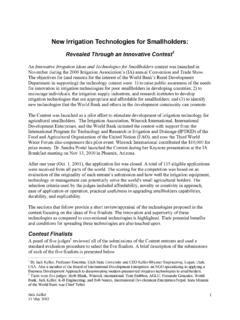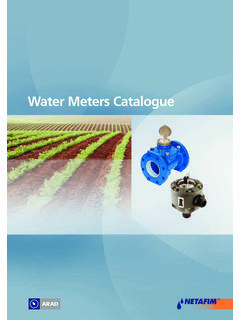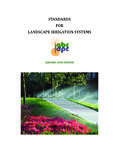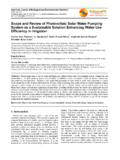Transcription of Gardening with Low-Cost Drip Irrigation in Kenya
1 Gardening with Low-Cost drip Irrigation in Kenya : For Health and Profit1. By Jack Keller2. Background Like other sub-Saharan countries, land and water resources are becoming even scarcer and arable land in Kenya has decreased from about 5 ha per person in 1960 to ha per person in 1998. The high population growth has contributed to this decline but it is evident that agricultural production has also kept pace perhaps because it was based on intensification policies, which are no longer feasible. Coupled with lack of appropriate technologies, this decline in per capita arable land is the main cause of declining food security and increasing poverty, which the country has been experiencing over the last decade. According to information I obtained from various sources (Ministry of Agriculture, Kenya Agricultural Research Institute, and the University of Nairobi) the estimated Irrigation potential of Kenya is somewhere between 250,000 and 540,000 ha depending on who made the estimate, and somewhere between 65,000 and 78,000 ha have been put under Irrigation to date.
2 Of this about 40% is privately managed by large firms, 20% is managed by the government, and 40% is managed by smallholders. However, because of inadequate maintenance it is estimated that less than 55,000 ha are now being utilized. The main constraints to Irrigation development are water availability and poor water management. While there are several efficient water use Irrigation systems, those used in Kenya are mainly traditional furrow and overhead sprinkler systems, which tend to use too much of the limited water. According to the Permanent Secretary, Ministry of Agriculture and Rural Development in his remarks at Low-head drip Irrigation Review Workshop in February 20003, the root cause of the poor economic performance, poverty and food insecurity in Kenya is because of unsound development policies. He stated that 1. This report was prepared by Jack Keller and presents the Kenyan results of a recent Fact Finding Study conducted in Kenya (1-5/3), India (6-11/3), and Nepal (12-17/3) in March 2001.
3 The purpose of the Study was to evaluate the potential and technical aspects of improving Irrigation performance and reducing poverty simultaneously through applying a market creation approach to development. The core of this market creation approach is to promote the sale of Low-Cost micro- Irrigation to poor farmers tending small plots. The Study was funded by the Swiss Agency for Development and Cooperation under a program championed by Dr. Urs Heierli. 2. Chief Executive Officer of Keller-Bliesner Engineering, Logan, Utah, Emeritus Professor of Irrigation Engineering at Utah State University, and Board Member of International Development Enterprises, Denver, Colorado, USA. 3. The proceedings of this workshop provide a very good source of background material on the state of the Low-Cost drip Irrigation situation in Kenya . The workshop was held at the National Agricultural Research Laboratories, Nairobi, 17 18 February 2000.
4 I was organized by Winrock International and the International Water Management Institute (IWMI). 1. everybody who has been attending seminars on public policy questions agree that there is presently a lack of new ideas and policy options. It seems that currently, everybody believes in the market logic, in privatisation and in the primacy of the private sector. But the policy debates should shift from discussing privatisation, retrenchment and incentives to the private sector, to finding why to assist small-scale rural agriculture. Poverty has entrenched itself in Kenya because the government had ignored the small-scale rural farmer and supported the large-scale farmers. He believes that Kenya achieved economic growth in the Sixties and the Seventies because the government implemented land redistribution policies. In other words, policies that gave the majority of the population improved access to economic assets and social services.
5 He expressed his conviction that such simple and adapted technologies as the small-scale drip Irrigation give the rural population improved access to economic asset (technologies). He continued by pointing out that increased production in the 60s and 70s was achieved mainly due to expansion of agriculture (extensification) into new areas in addition to new technologies. However, over the last 20 years, because of the rapid increases in population the option of extensification has dwindled. The Kenyan government is now convinced: a) that intensification of agriculture including use of Irrigation is the only solution to the problems of increasing agricultural productivity and hopefully food sufficiency and the reduction of poverty; and b) that appropriate technologies, in both improved crop varieties and soil and water management technologies, are the key to intensification.
6 Findings In the early 1970's widespread droughts and famines in Africa were reported in the news media. At the request of the Catholic Relief Services, Mr. Richard D. Chapin went to Senegal in 1974 to provide a small-scale drip system that could operate without a pump. This system operated from a bucket or small drum supported about a meter above the ground. It worked well and produced excellent vegetables where there was little or no rain. Since then Mr. Chapin has developed and promoted a simple, Low-Cost , and efficient drip Irrigation system, called a drip -kit . To make it possible for low-income families to afford these drip -kits for their subsistence needs in areas that faced long dry seasons, Chapin Watermatics now produces and sells the kits on a non-profit basis and promotes their use through the Chapin Living Water Foundation4. The Foundation has in place a training program on drip -kit use as well as training in dry season vegetable production.
7 In 1996 it assisted the Kenya Agricultural Research Institute (KARI) in introducing the Chapin drip -kits in Kenya with the objective of improving the economic conditions, nutrition level and enhanced food self-sufficiency of small-scale resource poor farmers. KARI's Role in drip Irrigation Since 1996 KARI has made use of grants from USAID and the World Bank and has imported, assembled, and sold/distributed over 3500 Chapin bucket-kits and roughly 400 1/8-acre (500 m2) drip systems. In addition KARI has established demonstration 4. Mr. Chapin formed the Chapin Living Waters Foundation to promote micro Irrigation for small plots in developing countries and he now serves as the Foundation's Executive Director. 2. drip -kit and Low-Cost drip Irrigation demonstration sites at the National Agricultural Research Laboratories (NARL) in Nairobi, the National Dryland Farming Research Center in Makueni, and the Regional Research Centers in Mtwapa and Perkerra.
8 The Agricultural Engineering Department of the University of Nairobi has also conducted research on the effectiveness of the bucket-kit drip Irrigation systems. Initially, for demonstration and promotional purposes, KARI freely distributed bucket-kits to various women's groups and NGOs working with small-scale poor farmers A bucket-kit has a 20-liter bucket that is supported 1-meter above the ground and supplies two 15-meter (or four ) long drip limes. The drip lines are lay-flat 16 mm tubing ( mm wall thickness) with internal long-tortuous-path emitters spaced at intervals. A bucket-kit supplies Irrigation to a small vegetable plot of 15 to 25 m2, depending on row spacing, and costs about $15. This is usually sufficient for a family's self-sufficiency in vegetables and many families even have some extra vegetable, which they market. Women own most of the bucket-kits and they also do the vegetable Gardening .
9 KARI researchers informed me that farmers report gross incomes of $40 to $60 per crop and grow two crops per year where there is sufficient water. KARI has recently scaled up the Chapin bucket-kit to what they call a drum-kit . It is comprised of 10 of the 15-meter long drip lines connected to a 200-liter drum to serve a plot of from 75 to 125 m2 (depending on row spacing) at a cost of about $100. They also provide a double drum-kit with 20 of the 15-meter long drip lines connected to a single 200-liter drum at a cost of about $135. KARI's 1/8-acre (500 m2) drip systems have a 50 mm diameter 15-meter long header that serves 20 drip lines that are each 30 meters long. The drip lines come in a 600- meter roll and are cut in the field. This system actually irrigates a 450 m2 plot and it costs about $200, which does not include the water supply5 or a head tank.
10 Currently KARI sells drip -kits to farmers and Projects. Farmers and donor-funded project personnel visit the demonstration sites and purchase the kits there. Some bucket-kits are still being donated to farmers through various charitable organizations but farmers are now directly purchasing roughly half of the kits that KARI sells. While survey results have indicated that many of the bucket-kits that have been given to farmers are not being fully utilized, most farmers who have purchased their kits use them for two crops per year except where the water supply has failed. Other Promoters of Low-Cost drip Systems Besides KARI there are a number of other institutions and groups that have begun marketing drip -kits. Following are some brief comments about some of these other actors. 5. If a Super MoneyMaker treadle pump supplied through Appropriate Technologies for Enterprise Creation's (ApproTEC) marketing system were used for the water supply this would add about $75 for the pump plus about $25 for the necessary hoses and head tanks.









